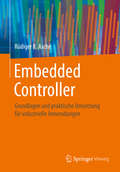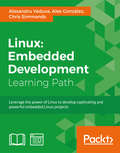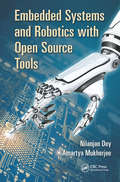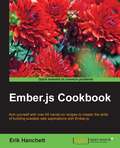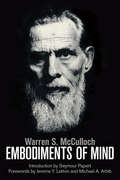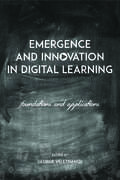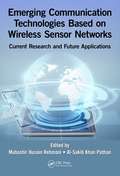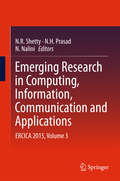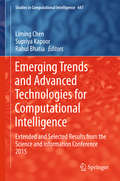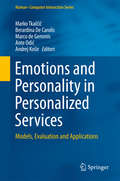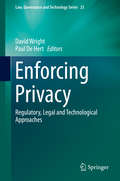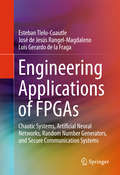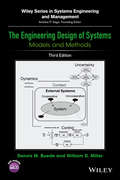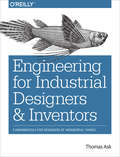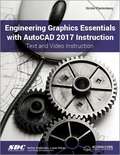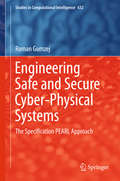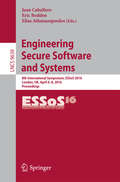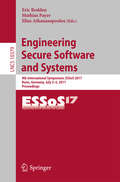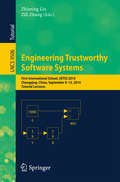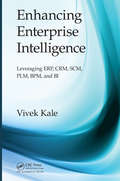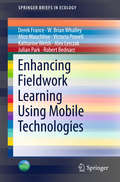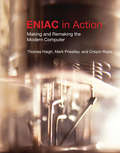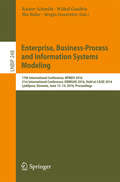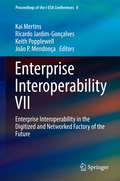- Table View
- List View
Email Discourse Among Chinese Using English as a Lingua Franca
by Gerald Rau Der-Hwa Victoria Rau Yuan-Shan ChenThis edited volume makes a valuable contribution to the burgeoning research field of English as a lingua franca. In a pioneering step, the collection is exclusively devoted to the English email discourse of Chinese speakers. The studies address innovative topics related to various contexts and relationships, using several different approaches and theories, which taken together shed light on how English serves as a lingua franca in multiple types of global written communication. The research topics presented are organized into four thematic sections, including emails from students to professors, emails from students to the international academic community, emails from peer to peer, and emails at the workplace. This collection of empirical research invites readers to consider the special features of apologies, requests, terms of address, politeness, and discourse organization, and how cultural differences may affect the use or interpretation of each. Throughout the book, readers will also discover how Chinese speakers use special features and strategies to construct their identity, establish relationships, and achieve successful communication in English. This highly informative, thought-provoking book also provides insights on methods for teaching email discourse using English as a lingua franca and suggests directions for future research.
Embedded Controller: Grundlagen und praktische Umsetzung für industrielle Anwendungen
by Rüdiger R. AscheDas Buch gewährt einen Einblick in die Architektur eingebetteter Systeme und den Entwicklungsprozess für die sie steuernde Firmware. Die Anforderungen an ein unbeaufsichtigt laufendes Embedded System sowie deren Umsetzung stehen dabei im Fokus. Alle Konzepte werden anhand von verbreiteten Komponenten wie ARM® Cortex® M3 und M4 basierten Prozessoren, FreeRTOS oder lwip praktisch umgesetzt. Praxistipps zur effizienten und zielgerichteten Nutzung von Debug-, Einkapselungs- und Analysewerkzeugen runden das Buch ab. Sie helfen sowohl dem Einsteiger als auch dem erfahrenen Profi bei der Entwicklung robuster und wartungsfreundlicher Firmware für Mikrocontroller im eingebetteten Umfeld.
Embedded Linux for Developers
by Alex Gonzalez Chris Simmonds Alexandru VaduvaLeverage the power of Linux to develop captivating and powerful embedded Linux projects About This Book * Explore the best practices for all embedded product development stages * Learn about the compelling features offered by the Yocto Project, such as customization, virtualization, and many more * Minimize project costs by using open source tools and programs Who This Book Is For If you are a developer who wants to build embedded systems using Linux, this book is for you. It is the ideal guide for you if you want to become proficient and broaden your knowledge. A basic understanding of C programming and experience with systems programming is needed. Experienced embedded Yocto developers will find new insight into working methodologies and ARM specific development competence. What You Will Learn * Use the Yocto Project in the embedded Linux development process * Get familiar with and customize the bootloader for a board * Discover more about real-time layer, security, virtualization, CGL, and LSB * See development workflows for the U-Boot and the Linux kernel, including debugging and optimization * Understand the open source licensing requirements and how to comply with them when cohabiting with proprietary programs * Optimize your production systems by reducing the size of both the Linux kernel and root filesystems * Understand device trees and make changes to accommodate new hardware on your device * Design and write multi-threaded applications using POSIX threads * Measure real-time latencies and tune the Linux kernel to minimize them In Detail Embedded Linux is a complete Linux distribution employed to operate embedded devices such as smartphones, tablets, PDAs, set-top boxes, and many more. An example of an embedded Linux distribution is Android, developed by Google. This learning path starts with the module Learning Embedded Linux Using the Yocto Project. It introduces embedded Linux software and hardware architecture and presents information about the bootloader. You will go through Linux kernel features and source code and get an overview of the Yocto Project components available. The next module Embedded Linux Projects Using Yocto Project Cookbook takes you through the installation of a professional embedded Yocto setup, then advises you on best practices. Finally, it explains how to quickly get hands-on with the Freescale ARM ecosystem and community layer using the affordable and open source Wandboard embedded board. Moving ahead, the final module Mastering Embedded Linux Programming takes you through the product cycle and gives you an in-depth description of the components and options that are available at each stage. You will see how functions are split between processes and the usage of POSIX threads. By the end of this learning path, your capabilities will be enhanced to create robust and versatile embedded projects. This Learning Path combines some of the best that Packt has to offer in one complete, curated package. It includes content from the following Packt products: * Learning Embedded Linux Using the Yocto Project by Alexandru Vaduva * Embedded Linux Projects Using Yocto Project Cookbook by Alex Gonzalez * Mastering Embedded Linux Programming by Chris Simmonds Style and approach This comprehensive, step-by-step, pragmatic guide enables you to build custom versions of Linux for new embedded systems with examples that are immediately applicable to your embedded developments. Practical examples provide an easy-to-follow way to learn Yocto project development using the best practices and working methodologies. Coupled with hints and best practices, this will help you understand embedded Linux better.
Embedded Systems and Robotics with Open Source Tools
by Nilanjan Dey Amartya MukherjeeEmbedded Systems and Robotics with Open-Source Tools provides easy-to-understand and easy-to-implement guidance for rapid prototype development. Designed for readers unfamiliar with advanced computing technologies, this highly accessible book: Describes several cutting-edge open-source software and hardware technologies Examines a number of embedded computer systems and their practical applications Includes detailed projects for applying rapid prototype development skills in real time Embedded Systems and Robotics with Open-Source Tools effectively demonstrates that, with the help of high-performance microprocessors, microcontrollers, and highly optimized algorithms, one can develop smarter embedded devices.
Ember.js cookbook
by Erik HanchettAnyone who wants to explore Ember.js and wishes to get hands on making sophisticated web apps with less coding will find this book handy. Prior experience in Coding and familiarity with JavaScript is recommended. If you've heard of Ember.js or are just curious on how a single-page application framework works, then this book is for you.
Embodiments of Mind (The\mit Press Ser.)
by Warren S. McCullochWritings by a thinker—a psychiatrist, a philosopher, a cybernetician, and a poet—whose ideas about mind and brain were far ahead of his time.Warren S. McCulloch was an original thinker, in many respects far ahead of his time. McCulloch, who was a psychiatrist, a philosopher, a teacher, a mathematician, and a poet, termed his work “experimental epistemology.” He said, “There is one answer, only one, toward which I've groped for thirty years: to find out how brains work.” Embodiments of Mind, first published more than fifty years ago, teems with intriguing concepts about the mind/brain that are highly relevant to recent developments in neuroscience and neural networks. It includes two classic papers coauthored with Walter Pitts, one of which applies Boolean algebra to neurons considered as gates, and the other of which shows the kind of nervous circuitry that could be used in perceiving universals. These first models are part of the basis of artificial intelligence.Chapters range from “What Is a Number, that a Man May Know It, and a Man, that He May Know a Number,” and “Why the Mind Is in the Head,” to “What the Frog's Eye Tells the Frog's Brain” (with Jerome Lettvin, Humberto Maturana, and Walter Pitts), “Machines that Think and Want,” and “A Logical Calculus of the Ideas Immanent in Nervous Activity” (with Walter Pitts). Embodiments of Mind concludes with a selection of McCulloch's poems and sonnets. This reissued edition offers a new foreword and a biographical essay by McCulloch's one-time research assistant, the neuroscientist and computer scientist Michael Arbib.
Emergence and Innovation in Digital Learning: Foundations and Applications
by George VeletsianosEducational systems worldwide are facing an enormous shift as a result of sociocultural, political, economic, and technological changes. The technologies and practices that have developed over the last decade have been heralded as opportunities to transform both online and traditional education systems. While proponents of these new ideas often postulate that they have the potential to address the educational problems facing both students and institutions and that they could provide an opportunity to rethink the ways that education is organized and enacted, there is little evidence of emerging technologies and practices in use in online education. Because researchers and practitioners interested in these possibilities often reside in various disciplines and academic departments the sharing and dissemination of their work across often rigid boundaries is a formidable task. Contributors to Emergence and Innovation in Digital Learning include individuals who are shaping the future of online learning with their innovative applications and investigations on the impact of issues such as openness, analytics, MOOCs, and social media. Building on work first published in Emerging Technologies in Distance Education, the contributors to this collection harness the dispersed knowledge in online education to provide a one-stop locale for work on emergent approaches in the field. Their conclusions will influence the adoption and success of these approaches to education and will enable researchers and practitioners to conceptualize, critique, and enhance their understanding of the foundations and applications of new technologies. With contributions by Terry Anderson, R. S. Baker, Angela D. Benson, Amy Collier, Alec Couros, Michael Dowdy, Margaret Edwards, B. J. Eib, Cassidy Hall, Katia Hildebrant, P. S. Inventado, Royce Kimmons, Trey Martindale, Rolin Moe, Beth Perry, Jen Ross, Elizabeth Wellburn, Andrew Whitworth.
Emerging Communication Technologies Based on Wireless Sensor Networks: Current Research and Future Applications
by Al-Sakib Khan Pathan Mubashir Husain RehmaniThis book fills a gap in the existing literature by combining a plethora of WSN-based emerging technologies into a single source so that reviewers can form opinions regarding these technologies. It presents different types of emerging communication technologies based on WSNs and describes how wireless sensor networks can be integrated with other communication technologies. It covers many of the new techniques and demonstrates the application of WSNs. The book is composed of 14 chapters, divided into four parts.
Emerging Research in Computing, Information, Communication and Applications
by N. R. Shetty N Hamsavath Prasad N. NaliniThis proceedings volume covers the proceedings of ERCICA 2015. ERCICA provides an interdisciplinary forum for researchers, professional engineers and scientists, educators, and technologists to discuss, debate and promote research and technology in the upcoming areas of Computing, Information, Communication and their Applications. The contents of this book cover emerging research areas in fields of Computing, Information, Communication and Applications. This will prove useful to both researchers and practicing engineers.
Emerging Trends and Advanced Technologies for Computational Intelligence
by Liming Chen Supriya Kapoor Rahul BhatiaThis book is a collection of extended chaptersfrom the selected papers that were published in the proceedings of Science andInformation (SAI) Conference 2015. It contains twenty-one chapters in the fieldof Computational Intelligence, which received highly recommended feedbackduring SAI Conference 2015 review process. During the three-day event 260scientists, technology developers, young researcher including PhD students, andindustrial practitioners from 56 countries have engaged intensively inpresentations, demonstrations, open panel sessions and informal discussions.
Emotions and Personality in Personalized Services
by Marko Tkalčič Berardina De Carolis Marco De Gemmis Ante Odić Andrej KoširPersonalization is ubiquitous from search engines to online-shopping websites helping us find content more efficiently and this book focuses on the key developments that are shaping our daily online experiences. With advances in the detection of end users' emotions, personality, sentiment and social signals, researchers and practitioners now have the tools to build a new generation of personalized systems that will really understand the user's state and deliver the right content. With leading experts from a vast array of domains from user modeling, mobile sensing and information retrieval to artificial intelligence, human-computer interaction (HCI) social computing and psychology, a broad spectrum of topics are covered. From discussing psychological theoretical models and exploring state-of-the-art methods for acquiring emotions and personality in an unobtrusive way, as well as describing how these concepts can be used to improve various aspects of the personalization process and chapters that discuss evaluation and privacy issues. Emotions and Personality in Personalized Systems will help aid researchers and practitioners develop and evaluate user-centric personalization systems that take into account the factors that have a tremendous impact on our decision-making - emotions and personality.
Enforcing Privacy
by Paul De Hert David WrightThis book is about enforcing privacy and data protection. It demonstrates different approaches - regulatory, legal and technological - to enforcing privacy. If regulators do not enforce laws or regulations or codes or do not have the resources, political support or wherewithal to enforce them, they effectively eviscerate and make meaningless such laws or regulations or codes, no matter how laudable or well-intentioned. In some cases, however, the mere existence of such laws or regulations, combined with a credible threat to invoke them, is sufficient for regulatory purposes. But the threat has to be credible. As some of the authors in this book make clear - it is a theme that runs throughout this book - "carrots" and "soft law" need to be backed up by "sticks" and "hard law". The authors of this book view privacy enforcement as an activity that goes beyond regulatory enforcement, however. In some sense, enforcing privacy is a task that befalls to all of us. Privacy advocates and members of the public can play an important role in combatting the continuing intrusions upon privacy by governments, intelligence agencies and big companies. Contributors to this book - including regulators, privacy advocates, academics, SMEs, a Member of the European Parliament, lawyers and a technology researcher - share their views in the one and only book on Enforcing Privacy.
Engineering Applications of FPGAs
by Esteban Tlelo-Cuautle José de Jesús Rangel-Magdaleno Luis Gerardo De la FragaThis book offers readers a clear guide to implementing engineering applications with FPGAs, from the mathematical description to the hardware synthesis, including discussion of VHDL programming and co-simulation issues. Coverage includes FPGA realizations such as: chaos generators that are described from their mathematical models; artificial neural networks (ANNs) to predict chaotic time series, for which a discussion of different ANN topologies is included, with different learning techniques and activation functions; random number generators (RNGs) that are realized using different chaos generators, and discussions of their maximum Lyapunov exponent values and entropies. Finally, optimized chaotic oscillators are synchronized and realized to implement a secure communication system that processes black and white and grey-scale images. In each application, readers will find VHDL programming guidelines and computer arithmetic issues, along with co-simulation examples with Active-HDL and Simulink. The whole book provides a practical guide to implementing a variety of engineering applications from VHDL programming and co-simulation issues, to FPGA realizations of chaos generators, ANNs for chaotic time-series prediction, RNGs and chaotic secure communications for image transmission.
The Engineering Design of Systems
by Dennis M. Buede William D. MillerNew for the third edition, chapters on: Complete Exercise of the SE Process, System Science and Analytics and The Value of Systems Engineering The book takes a model-based approach to key systems engineering design activities and introduces methods and models used in the real world. This book is divided into three major parts: (1) Introduction, Overview and Basic Knowledge, (2) Design and Integration Topics, (3) Supplemental Topics. The first part provides an introduction to the issues associated with the engineering of a system. The second part covers the critical material required to understand the major elements needed in the engineering design of any system: requirements, architectures (functional, physical, and allocated), interfaces, and qualification. The final part reviews methods for data, process, and behavior modeling, decision analysis, system science and analytics, and the value of systems engineering. Chapter 1 has been rewritten to integrate the new chapters and updates were made throughout the original chapters. Provides an overview of modeling, modeling methods associated with SysML, and IDEF0 Includes a new Chapter 12 that provides a comprehensive review of the topics discussed in Chapters 6 through 11 via a simple system - an automated soda machine Features a new Chapter 15 that reviews General System Theory, systems science, natural systems, cybernetics, systems thinking, quantitative characterization of systems, system dynamics, constraint theory, and Fermi problems and guesstimation Includes a new Chapter 16 on the value of systems engineering with five primary value propositions: systems as a goal-seeking system, systems engineering as a communications interface, systems engineering to avert showstoppers, systems engineering to find and fix errors, and systems engineering as risk mitigation The Engineering Design of Systems: Models and Methods, Third Edition is designed to be an introductory reference for professionals as well as a textbook for senior undergraduate and graduate students in systems engineering.
Engineering for Industrial Designers and Inventors: Fundamentals for Designers of Wonderful Things
by Thomas AskIf you have designs for wonderful machines in mind, but aren't sure how to turn your ideas into real, engineered products that can be manufactured, marketed, and used, this book is for you. Engineering professor and veteran maker Tom Ask helps you integrate mechanical engineering concepts into your creative design process by presenting them in a rigorous but largely nonmathematical format.Through mind stories and images, this book provides you with a firm grounding in material mechanics, thermodynamics, fluid dynamics, and heat transfer. Students, product and mechanical designers, and inventive makers will also explore nontechnical topics such as aesthetics, ethnography, and branding that influence product appeal and user preference.Learn the importance of designing functional products that also appeal to users in subtle waysExplore the role of aesthetics, ethnography, brand management, and material culture in product designDive into traditional mechanical engineering disciplines related to the behavior of solids, liquids, and gasesUnderstand the human factors of design, such as ergonomics, kinesiology, anthropometry, and biomimicryGet an overview of available mechanical systems and components for creating your product
Engineering Graphics Essentials With AutoCAD 2017 Instruction
by Kirstie PlantenbergEngineering Graphics Essentials with AutoCAD 2009 Instruction covers the main topics of engineering graphics, including tolerancing and fasteners, giving the user a basic understanding of how to create and read engineering drawings as well as teaching them the fundamentals of AutoCAD 2009.
Engineering Safe and Secure Cyber-Physical Systems
by Roman GumzejThis book introduces the concept of holistic designand development of cyber physical systems to achieve their safe and secureoperation. It shows that by following the standards for embedded system'ssafety and using appropriate hardware and software components inherently safesystem's architectures can be devised and certified. While the standardsalready enable testing and certification of inherently safe and sound hardware,this is still not the case with software. The book demonstrates that SpecificationPEARL(SPEARL) addresses this issue and proposes appropriate solutions from theviewpoints of software engineering as well as concrete program components. Bydoing so it reduces the complexity of cyber physical systems design in aninnovative way. Three ultimate goals are being followed in thecourse of defining this new PEARL standard, namely: 1. simplicity over complexity, 2. inherent real-time ability, and 3. conformity to safety integrity and securitycapability levels.
Engineering Secure Software and Systems
by Elias Athanasopoulos Eric Bodden Juan CaballeroThis book constitutes the refereed proceedings of the 8th International Symposium on Engineering Secure Software and Systems, ESSoS 2016, held in London, UK, in April 2016. The 13 full papers presented together with 3 short papers and 1 invited talk were carefully reviewed and selected from 50 submissions. The goal of this symposium, is to bring together researchers and practitioners to advance the states of the art and practice in secure software engineering. The presentations and associated publications at ESSoS 2016 contribute to this goal in several directions: First, by improving methodologies for secure software engineering (such as flow analysis and policy compliance). Second, with results for the detection and analysis of software vulnerabilities and the attacks they enable. Finally, for securing software for specific application domains (such as mobile devices and access control).
Engineering Secure Software and Systems
by Eric Bodden Mathias Payer Elias AthanasopoulosThis book constitutes the refereed proceedings of the 8th International Symposium on Engineering Secure Software and Systems, ESSoS 2016, held in London, UK, in April 2016. The 13 full papers presented together with 3 short papers and 1 invited talk were carefully reviewed and selected from 50 submissions. The goal of this symposium, is to bring together researchers and practitioners to advance the states of the art and practice in secure software engineering. The presentations and associated publications at ESSoS 2016 contribute to this goal in several directions: First, by improving methodologies for secure software engineering (such as flow analysis and policy compliance). Second, with results for the detection and analysis of software vulnerabilities and the attacks they enable. Finally, for securing software for specific application domains (such as mobile devices and access control).
Engineering Trustworthy Software Systems
by Zhiming Liu Zili ZhangThis volume contains the lecture notes of the five coursesand one seminar given at the School on Engineering Trustworthy Software Systems(SETSS 2014), held in September 2014 at Southwest University in Chongqing,China. The material is useful for postgraduate students,researchers, academics and industrial engineers who are interested in thetheory and practice of methods and tools for the design and programming oftrustworthy software systems. The common themes of the courses include thedesign and use of theories, techniques and tools for software specification andmodeling, analysis and verification. The courses cover sequential programming,component- and object software, hybrid systems and cyber-physical systems withchallenges of termination, security, safety, security, fault-tolerance andreal-time requirements. The techniques include model checking, correctness byconstruction through refinement and model transformations, synthesis andcomputer algebra.
Enhancing Enterprise Intelligence: Leveraging ERP, CRM, SCM, PLM, BPM, and BI
by Vivek KaleEnhancing Enterprise Intelligence: Leveraging ERP, CRM, SCM, PLM, BPM, and BI takes a fresh look at the benefits of enterprise systems (ES), focusing on the fact that ES collectively contribute to enhancing the intelligence quotient of an enterprise. The book provides an overview of the characteristic domains (i.e., business functions, processes, a
Enhancing Fieldwork Learning Using Mobile Technologies
by Derek France W. Brian Whalley Alice Mauchline Victoria Powell Katharine Welsh Alex Lerczak Julian Park Robert BednarzThis book shows how tablets (and smartphones) using a variety of selected 'apps', can enhance fieldwork and other out-of-classroom activities. The authors review imaginative uses of tablets from their own project and as well as examples from other colleagues. To help readers keep abreast of new technology and innovative ways to use it, the book is supported by a web site and a social media community.
ENIAC in Action: Making and Remaking the Modern Computer (History of Computing)
by Thomas Haigh Mark Priestley Crispin RopeThe history of the first programmable electronic computer, from its conception, construction, and use to its afterlife as a part of computing folklore.Conceived in 1943, completed in 1945, and decommissioned in 1955, ENIAC (the Electronic Numerical Integrator and Computer) was the first general-purpose programmable electronic computer. But ENIAC was more than just a milestone on the road to the modern computer. During its decade of operational life, ENIAC calculated sines and cosines and tested for statistical outliers, plotted the trajectories of bombs and shells, and ran the first numerical weather simulations. ENIAC in Action tells the whole story for the first time, from ENIAC's design, construction, testing, and use to its afterlife as part of computing folklore. It highlights the complex relationship of ENIAC and its designers to the revolutionary approaches to computer architecture and coding first documented by John von Neumann in 1945.Within this broad sweep, the authors emphasize the crucial but previously neglected years of 1947 to 1948, when ENIAC was reconfigured to run what the authors claim was the first modern computer program to be executed: a simulation of atomic fission for Los Alamos researchers. The authors view ENIAC from diverse perspectives—as a machine of war, as the “first computer,” as a material artifact constantly remade by its users, and as a subject of (contradictory) historical narratives. They integrate the history of the machine and its applications, describing the mathematicians, scientists, and engineers who proposed and designed ENIAC as well as the men—and particularly the women who—built, programmed, and operated it.
Enterprise, Business-Process and Information Systems Modeling
by Rainer Schmidt Wided Guédria Ilia Bider Sérgio GuerreiroThis book contains the refereed proceedings of the 17th International Conference on Business Process Modeling, Development and Support, BPMDS 2016, and the 21st International Conference on Exploring Modeling Methods for Systems Analysis and Design, EMMSAD 2016, held together with the 28th International Conference on Advanced Information Systems Engineering (CAiSE 2016) in Ljubljana, Slovenia, in June 2016. The focus theme for BPMDS 2016 papers was "Business Processes in a Connected World", for which three subthemes were identified: business processes for connecting people, connecting intelligent objects to business processes and connecting information/data/knowledge to business processes. The 17 full and 1 short paper accepted for BPMDS were selected from 48 submissions and are grouped into topical sections on process execution support; improving usability of process models; social and human perspectives; new directions in process modeling; consistency, correctness and compliance; process and data mining; and process variability. The intention of EMMSAD is to solicit papers related to the field of information systems analysis and design including numerous information modeling methods and notations that are typically evolving. These ongoing changes significantly impact the way information systems, enterprises, and business processes are being analyzed and designed in practice. The 12 full papers accepted for EMMSAD were chosen from 19 submissions and are grouped into topical sections on fundamental issues in modeling; requirements and regulations; enterprise and software ecosystem modeling; information and process model quality; meta-modeling and domain specific modeling and model composition; and modeling of architecture and design.
Enterprise Interoperability VII
by Kai Mertins Ricardo Jardim-Gonçalves Keith Popplewell João P. MendonçaA concise reference to the state of theart in systems interoperability, EnterpriseInteroperability VII will be of great value to engineers and computerscientists working in manufacturing and other process industries and tosoftware engineers and electronic and manufacturing engineers working in theacademic environment. Furthermore, it shows how knowledge of the meaning withininformation and the use to which it will be put have to be held in commonbetween enterprises for consistent and efficient inter-enterprise networks. Over 30 papers, ranging from academicresearch through case studies to industrial and administrative experience ofinteroperability show how, in a scenario of globalised markets, where thecapacity to cooperate with other organizations efficiently is essential inorder to remain economically, socially and environmentally cost-effective, themost innovative digitized and networked enterprises ensure that their systems and applications are ableto interoperate across heterogeneous collaborative networks of independent organizations. This goal of interoperability is essential, not only from the perspective ofthe individual enterprise but also in the business structures that are nowemerging, such as complex collaborating networks of suppliers and customers,virtual enterprises, interconnected organisations or extended enterprises, aswell as in mergers and acquisitions. Establishing efficient and relevantcollaborative situations requires the management of interoperability from adynamic point of view: a relevant and efficient collaboration of organizations mayrequire adaptation to remain in line with changing objectives, evolvingresources, unexpected events, etc. Many of the papers contained in this, the eighthvolume of Proceedings of the I-ESAConferences have examples and illustrations calculated to deepenunderstanding and generate new ideas. The I-ESA'16 Conferencefrom which this book is drawn was organized by the Escola de Engenharia daUniversidade do Minho, on behalf of the European Virtual Laboratory for EnterpriseInteroperability (INTEROP-VLab) and Interop VLab Portuguese Pole.

